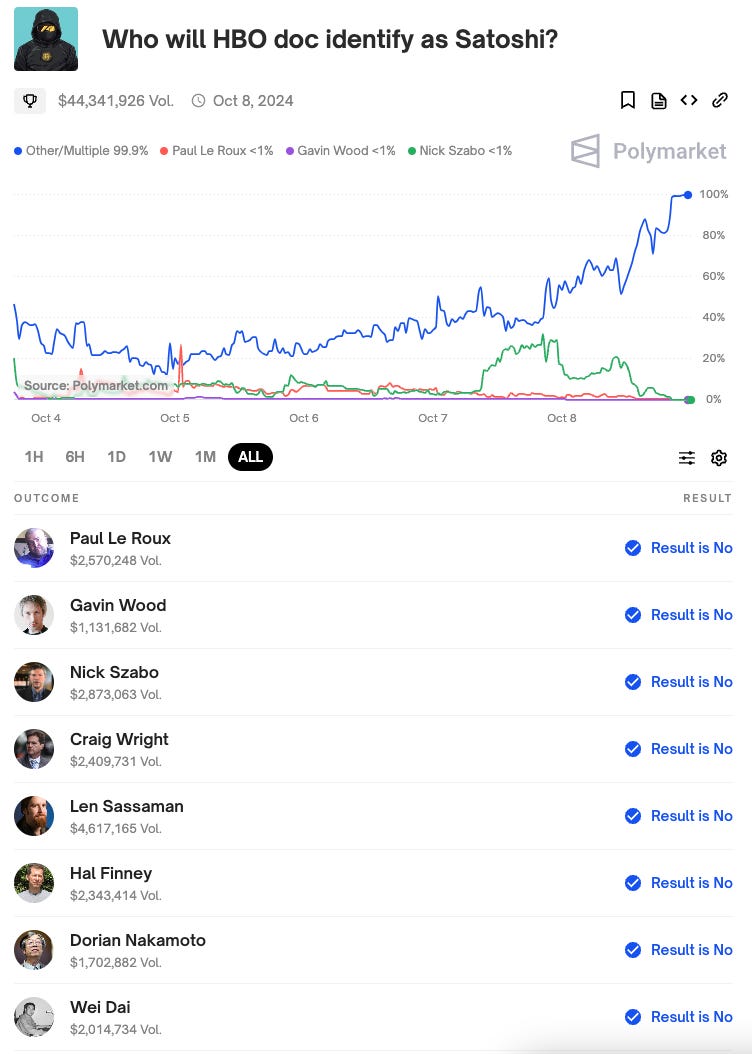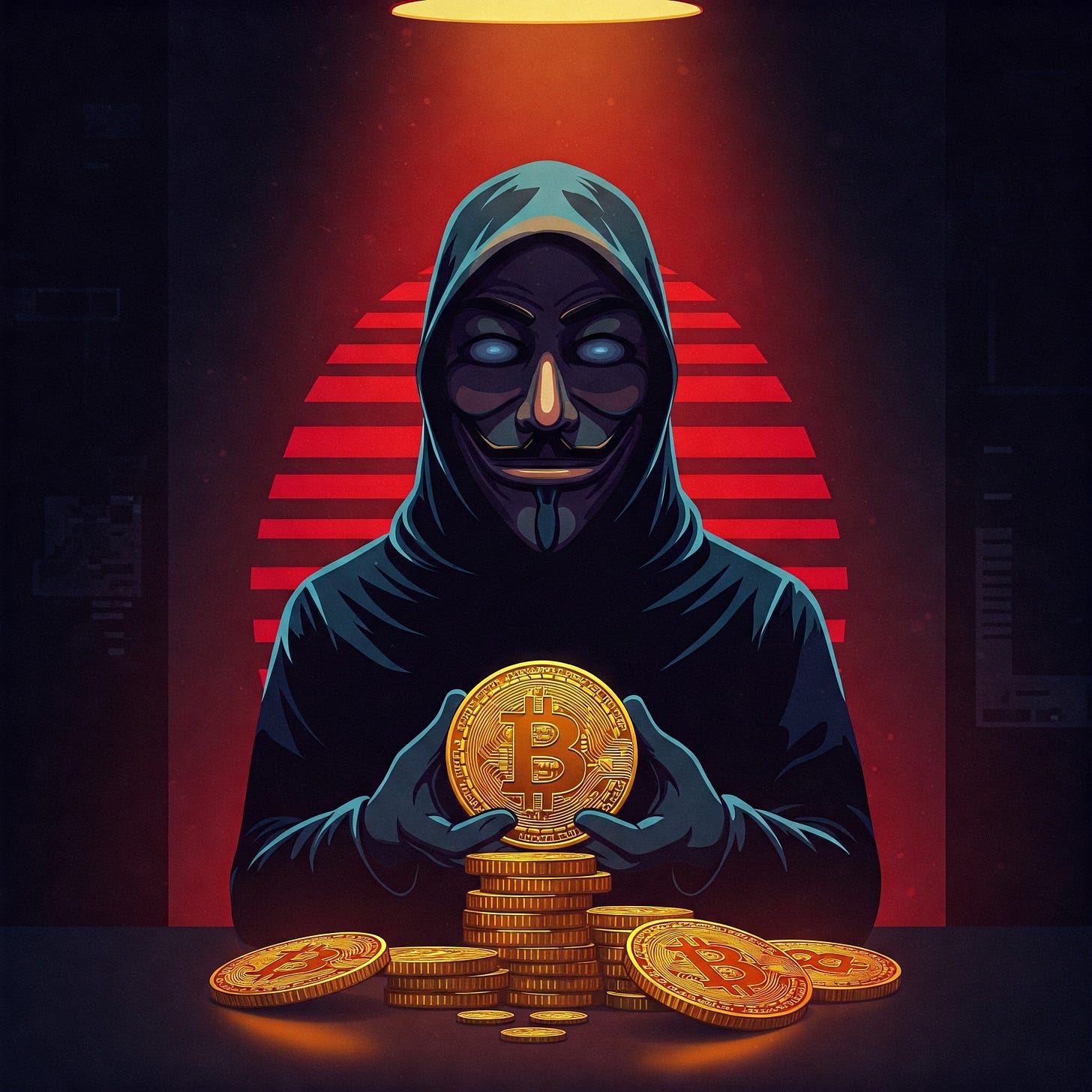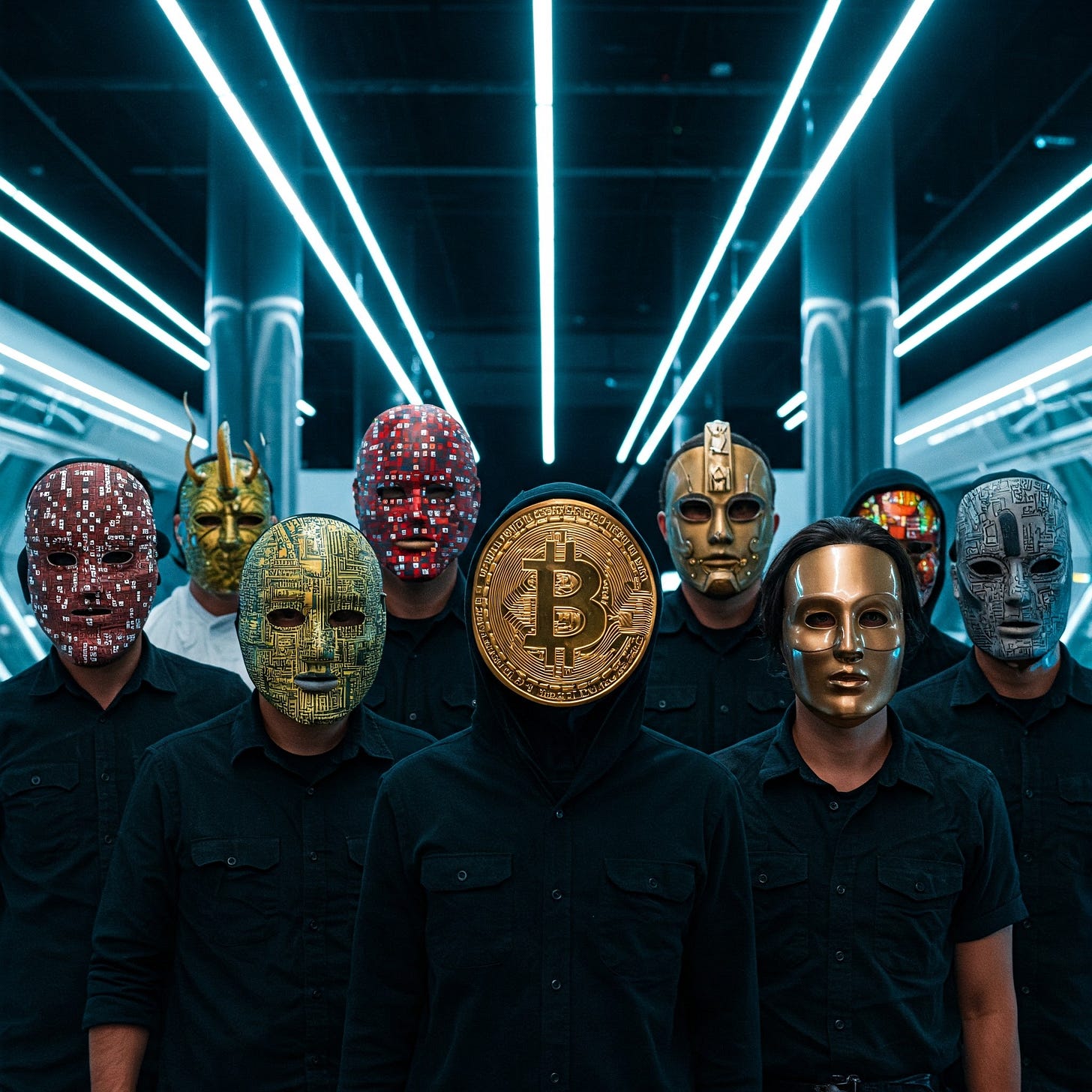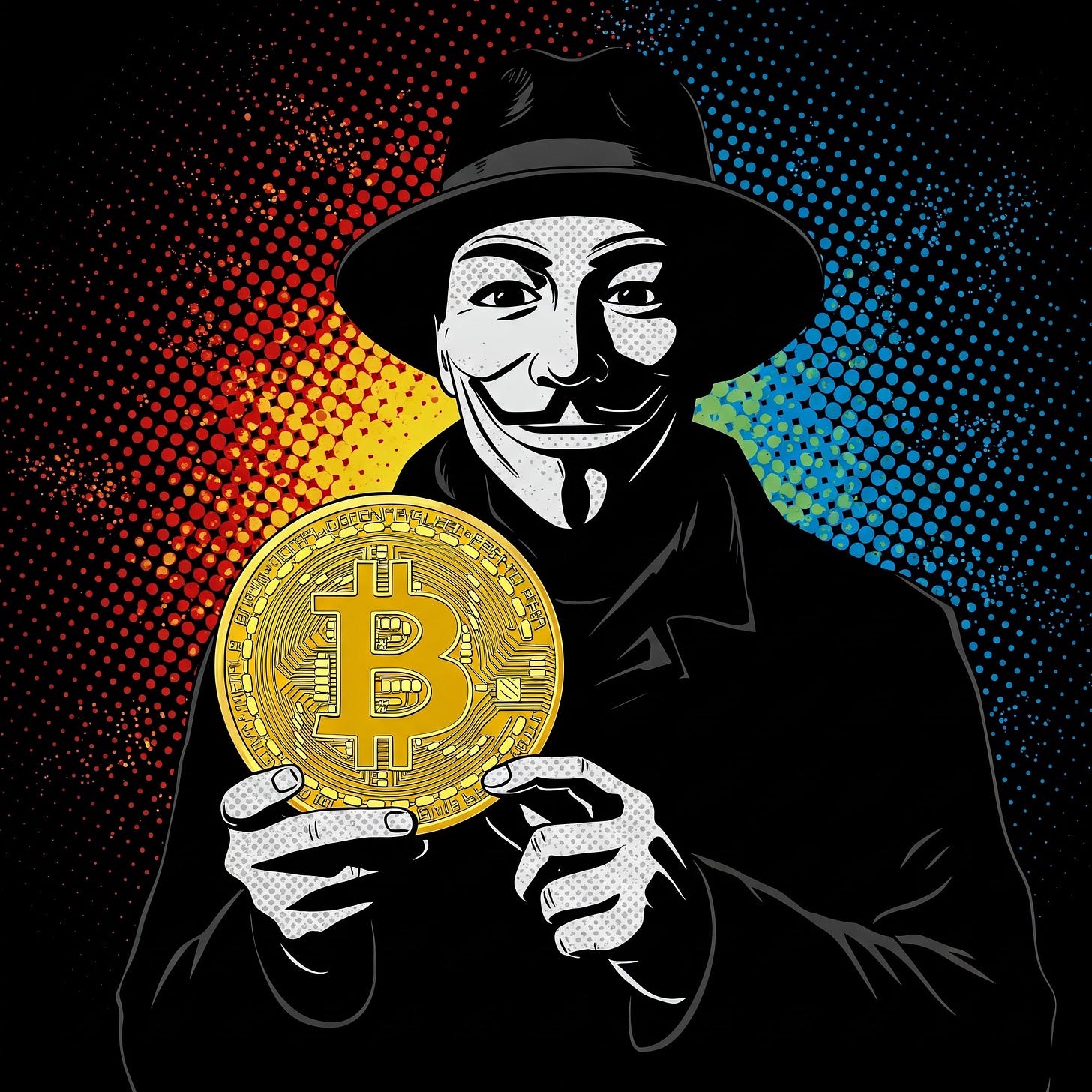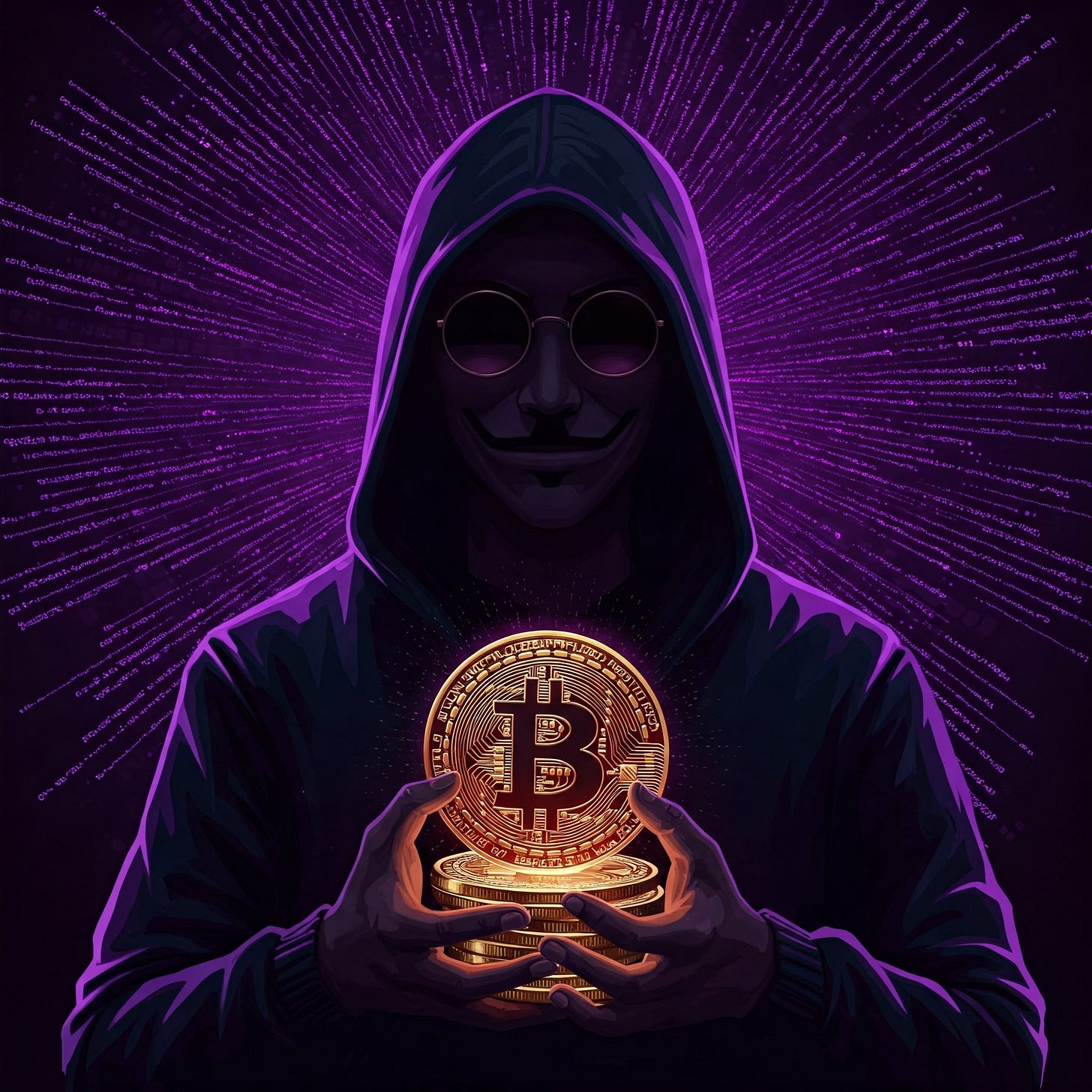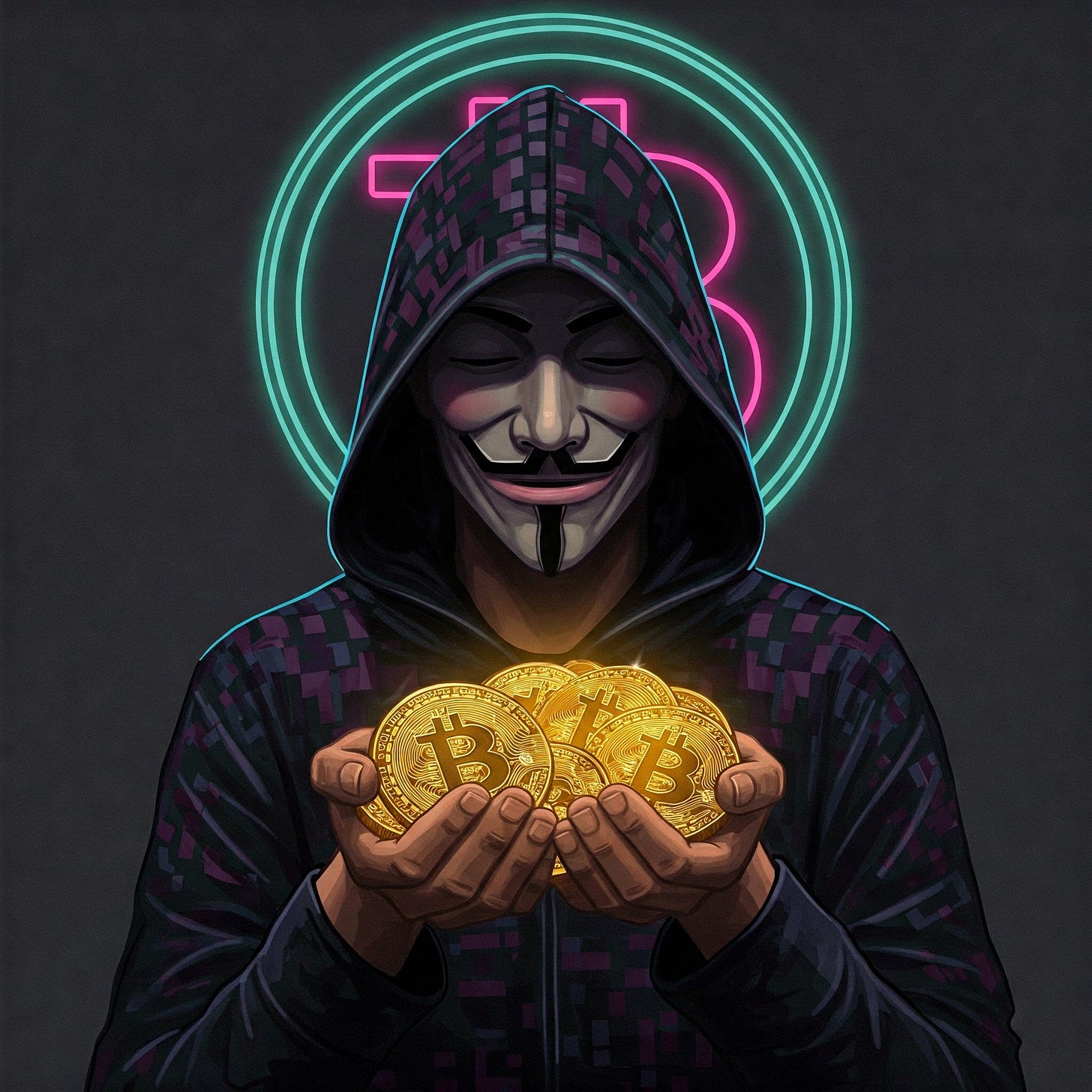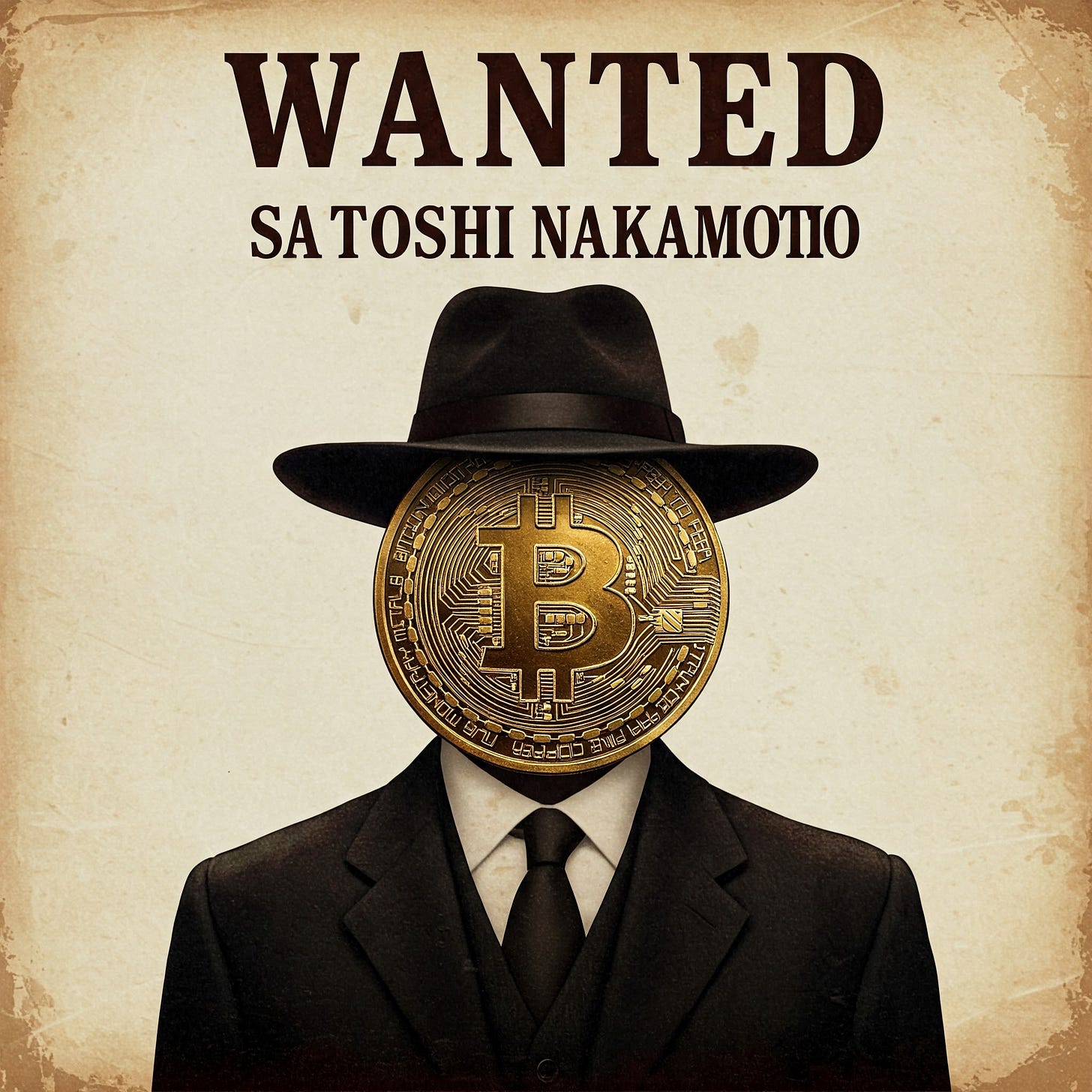Who is Satoshi Nakamoto? Bitcoin Creator (2025 Analysis): Szabo, Finney, Back, Sassaman, Le Roux
Who TF is Satoshi? Szabo and Finney highest odds... Back, Sassaman, Le Roux round out the Top 5. Might also be a cohort.
I compiled info/data strewn across the internet, tasked AI to do some “deep research,” in attempt to determine who is most likely to be Satoshi Nakamoto, the pseudonymous creator of Bitcoin (BTC).
Back in 2024 there was a Polymarket bet on the person who would be revealed as Satoshi in the HBO documentary “Money Electric: The Bitcoin Mystery”… the reveal? Nothing.
Although the doc raised a theory that Bitcoin’s creator might be Peter Todd, it didn’t provide any convincing proof… just circumstantials. Todd denied being Satoshi and he’s now being hounded by randoms assuming he is.
Polymarket betting odds that I had archived from Oct 4, 2024 (for who would be announced as Satoshi on HBO’s Money Electric) were:
Sassaman: 49%
Group: 24%
Finney: 11%
Back: 8%
Le Roux: 8%
Szabo: 3%
Wright: 1%
Others: <1%
The market settled as a “No” (as in none of the listed individuals were identified in the documentary as being Satoshi).
I didn’t bother watching the doc… maybe will get around to it. Keep in mind that Satoshi could also be a group of people.
Satoshi Nakamoto (Basic Overview)
When it comes to Bitcoin, Satoshi Nakamoto is a legendary figure.
Under this pseudonym, Bitcoin’s creator released a whitepaper in 2008, launched the Bitcoin network in 2009, and then vanished from public view in 2011.
The significance of Satoshi’s contribution cannot be overstated:
Architect of a Financial Revolution: By creating the first decentralized digital currency, Satoshi paved the way for a global crypto ecosystem.
Owner of a Vast Fortune: Satoshi is believed to control approximately ~1.1 million BTC—worth tens of billions of dollars—none of which has ever moved beyond a few test transactions.
Beacon of Decentralization: Satoshi’s anonymity reinforced Bitcoin’s ethos: an open-source, leaderless network whose value and governance lie with its users rather than a central authority.
Today, Satoshi’s identity remains one of technology’s greatest unsolved mysteries, fueling speculation among journalists, researchers, cryptographers, and the general public.
A Brief History of Satoshi Nakamoto
Pre-Release (2007–2008)
Mid-2007: Satoshi reportedly begins coding what would become Bitcoin.
August 18, 2008: The domain bitcoin.org is registered.
October 31, 2008: Satoshi publishes the whitepaper, “Bitcoin: A Peer-to-Peer Electronic Cash System,” on the Cryptography Mailing List.
The Genesis Block (Jan 3, 2009)
The Bitcoin network officially launches with the mining of the first (“genesis”) block.
Embedded text: “The Times 03/Jan/2009 Chancellor on brink of second bailout for banks.”
This message from a London newspaper headline served as both timestamp and subtle commentary on the banking crisis.
First Release & Early Transactions (Jan 9 & 12)
January 9, 2009: Satoshi releases Bitcoin version 0.1 on SourceForge, marking the software’s first public availability.
January 12, 2009: The very first Bitcoin transaction—10 BTC—is sent by Satoshi to cryptographer Hal Finney.
Active Development (2009–2010)
Satoshi leads Bitcoin’s development, regularly posting on email threads and the Bitcointalk forum.
He remains cautious about personal details: never shares real-world information, and writes primarily in an English style that occasionally uses British spellings.
Vanishing Act (Late 2010–April 2011)
December 12, 2010: Satoshi’s final known forum post on Bitcointalk. The next day, he stops posting entirely.
April 2011: Satoshi’s last verified email to developers states: “I have moved on to other things. It’s in good hands.” After this, Satoshi never surfaces again.
Over the subsequent years, these 1 million BTC Satoshi likely mined in the early days have remained untouched. No conclusive communications from Satoshi have emerged, leaving researchers only scattered breadcrumbs—and a global puzzle.
Satoshi: The Mystery & Key Clues
1. Time Zone Patterns
Stefan Thomas’s analysis of Satoshi’s forum activity found he never posted between roughly 5 AM and 11 AM GMT (including weekends).
This suggests he might have been located in a US time zone or somewhere in the Western hemisphere, casting doubt on the claim of being a native Japanese individual.
2. British English Indicators
Satoshi’s writings include British spellings (e.g., colour, grey, maths), and occasional British idioms (“bloody hard,” “flat” for apartment).
This points toward someone with either UK origins, Commonwealth background, or deliberate style choices.
3. Untouched Fortune
Satoshi’s Bitcoin stash—valued at billions of dollars—has never been spent.
Whether this is due to ideological conviction, loss of private keys, legal fears, or even Satoshi’s death is hotly debated.
4. Style & Technical Mastery
Bitcoin’s design weaves together cryptographic proof-of-work, peer-to-peer networking, and economic incentives.
Satoshi’s code and writings show deep familiarity with these domains, adding to the challenge of identifying a single person with all those skill sets.
Who is Satoshi Nakamoto? Power Rankings of Leading Candidates (Odds & Rationale)
Listed below are the top contenders identified by extensive research, stylometric analysis, and community consensus.
Next to each name is an estimated probability (a subjective measure) that this person (or group) is Satoshi Nakamoto.
1.) Nick Szabo (25-30%)
Background: A computer scientist, cryptographer, and legal scholar credited with pioneering “smart contracts.” Notably, he created Bit Gold in 1998, a decentralized digital currency concept very similar to Bitcoin.
Bit Gold Precursor: The conceptual overlap between Bit Gold and Bitcoin is massive.
Linguistic Forensics: Multiple stylometric studies find Szabo’s writing nearly identical to Satoshi’s. Researchers at Aston University conducted a study in 2014 and called the match “indisputable.” A researcher named Skye Grey came to a similar conclusion (Szabo = Satoshi).
Omission in Whitepaper: Bitcoin’s whitepaper cites Wei Dai and Adam Back but not Bit Gold, even though it’s arguably the most direct influence—perhaps an intentional omission if Szabo was Satoshi, to avoid self-reference.
Counterpoints:
Szabo steadfastly denies being Satoshi.
Some time-zone and coding-style clues don’t align perfectly with Szabo’s known habits.
Rationale: Szabo’s deep involvement in digital currency theory, matching linguistic style, and references by figures like Elon Musk make him a prime suspect. If we rely on stylometric evidence, Szabo often tops the list. (LINK)
2.) Hal Finney (20-25%)
Background: A revered cryptographer and software developer, Finney was an early Bitcoin user, receiving the very first transaction from Satoshi.
Technical Fit: Created Reusable Proof-of-Work (RPoW) in 2004, a forerunner to Bitcoin’s proof-of-work concept.
Direct Involvement: First collaborator after Satoshi’s launch, participated in bug fixes, and corresponded with Satoshi frequently.
Writing Similarities: Some stylometric analyses show partial alignment between Finney’s writing and Satoshi’s.
Health Timing: Diagnosed with ALS in 2009; his condition worsened around 2010–2011, coinciding with Satoshi’s disappearance.
Counterpoints:
Finney openly denied being Satoshi, even sharing personal emails from Satoshi as a separate individual.
By all accounts, he was transparent, well-liked, and not prone to deception.
Rationale: Many in the community consider Finney the strongest single-person candidate, given his direct role and cryptographic brilliance. The main question is whether he would engage in an elaborate ruse—something his personal integrity makes unlikely, yet not impossible.
3.) Adam Back (15%)
Background: A British cryptographer and inventor of Hashcash—the proof-of-work algorithm that directly inspired Bitcoin mining. He was part of the cypherpunk community where Satoshi first announced Bitcoin.
Hashcash Connection: Bitcoin’s whitepaper explicitly references Hashcash.
British English: Matches Satoshi’s writing style more naturally than an American might.
Early Involvement: Satoshi allegedly emailed Back directly about Bitcoin before its public release.
Counterpoints:
Back denies being Satoshi, and no conclusive stylometric match has been found.
Satoshi’s activity patterns align slightly more with US time zones than the UK, though this is not definitive.
Rationale: Adam Back’s cryptographic expertise and early communications with Satoshi place him high on the suspect list. Some believe if Satoshi was actually a team, Back could have been a key member.
4.) Len Sassaman (15%)
Background: A respected computer scientist and privacy advocate. He was an active cypherpunk, close to Hal Finney and others. Sassaman tragically died by suicide in July 2011, around the time Satoshi vanished.
Cypherpunk Ties: Collaborated with or knew many early Bitcoin figures.
Suspicious Timing: Satoshi’s last known communication was April 2011; Sassaman died a few months later.
Community Speculation: Some believe his death might explain why Satoshi never returned.
Counterpoints:
No direct link (writings, emails, code) tying Sassaman to Bitcoin’s creation.
If Sassaman were part of a group, he wasn’t publicly acknowledged.
Rationale: Sassaman’s cryptographic background and the abrupt end to Satoshi’s messages after Sassaman’s death are compelling for some. Betting markets recently fueled speculation that HBO’s documentary would name him Satoshi.
5.) Paul Le Roux (10%)
Background: A software engineer turned criminal mastermind, known for arms trafficking and running online pill pharmacies. Arrested in 2012 by the DEA.
Technical Skills: Authored encryption software (E4M, TrueCrypt) and had an interest in digital currencies.
Timing: His arrest in 2012 and Satoshi’s disappearance around 2011–2012 feed a dramatic theory that Satoshi was forced into silence.
Alias “Solotshi”: Found on one of Le Roux’s fake IDs, reminiscent of “Satoshi.”
Counterpoints:
No direct coding or stylistic overlap between Bitcoin and Le Roux’s known projects.
No blockchain evidence linking his criminal empire to early Bitcoin usage.
Rationale: Though sensational, the “criminal overlord” theory lacks solid proof. It remains a niche hypothesis, driven more by the compelling narrative than verifiable evidence.
6.) Wei Dai (7%)
Background: Creator of b-money, an early decentralized digital currency concept cited in Bitcoin’s whitepaper. A noted cryptographer but not publicly involved in Bitcoin’s coding.
b-money Influence: Satoshi explicitly references Dai’s work.
Technical Alignment: Dai’s ideas were foundational for Bitcoin’s structure.
Counterpoints:
Dai has never claimed to be Satoshi and was not active in coding Bitcoin’s release.
Rationale: More likely an influential precursor than the actual Bitcoin architect.
7.) Neal King, Vladimir Oksman, Charles Bry (5%)
Background: Co-authors of a 2008 patent application containing language similar to the Bitcoin whitepaper (“computationally impractical to reverse”).
Linguistic Overlap: The suspicious phrase appears in both the patent and Satoshi’s text.
Domain Registration Timing: Their patent filing predates bitcoin.org registration.
Counterpoints:
All 3 deny involvement.
No other connection to Bitcoin’s launch.
Rationale: A coincidence? Likely, given the lack of further evidence.
8.) David Chaum (3%)
Background: A pioneering cryptographer who created eCash and DigiCash in the 1990s.
Digital Currency Visionary: Chaum’s work introduced anonymous electronic payments.
Conceptual Similarities: eCash was a precursor to many digital money concepts.
Counterpoints:
Chaum’s systems were centralized; Bitcoin is decentralized.
No direct proof linking him to Bitcoin.
Rationale: A giant in digital currency history, but eCash’s centralized design differs significantly from Bitcoin.
9.) Gavin Andresen (3%)
Background: The developer Satoshi handpicked to lead Bitcoin after stepping away.
Close Contact: Satoshi entrusted Gavin with the alert keys and code repository.
Counterpoints:
Andresen has always denied being Satoshi, and the project “handover” implies two different people.
No stylometric alignment.
Rationale: Likely just Satoshi’s chosen successor rather than Satoshi himself.
10.) Dustin D. Trammell (2%)
Background: An early Bitcoin miner and security researcher. Engaged with Satoshi on technical issues.
Early Adopter: Among the first to mine and discuss Bitcoin.
Counterpoints:
Trammell has denied being Satoshi, and no direct link suggests otherwise.
Rationale: Another early participant but not convincingly the creator.
11.) Michael Clear (1%)
Background: Cryptography graduate student flagged by a 2011 New Yorker article.
Academic Expertise: Studied cryptography at Trinity College Dublin.
Counterpoints:
He publicly denied any involvement and no direct proof ever emerged.
Rationale: Mostly a media-fueled hypothesis that never gained traction.
12.) Dorian Prentice S. Nakamoto (0.1%)
Background: A Japanese-American man named “Satoshi Nakamoto,” misidentified by Newsweek in 2014.
Name Similarity: The only “evidence” was the identical legal name.
Engineering Background: He worked as a systems engineer, fueling speculation.
Counterpoints:
Dorian denied ever hearing of Bitcoin until journalists contacted him.
Satoshi’s dormant P2P Foundation account posted “I am not Dorian Nakamoto” immediately after the story broke.
Rationale: A classic case of mistaken identity—he’s overwhelmingly considered not Satoshi.
13.) Craig Wright (0.1%)
Background: Australian entrepreneur who publicly claimed to be Satoshi in 2015–2016.
Self-Assertions: Wright attempted to show cryptographic “proof,” which was quickly debunked as fraudulent.
Media Coverage: Wired and Gizmodo initially reported on leaked documents naming him.
Counterpoints:
Multiple instances of forged evidence and contradictions.
A 2024 UK High Court ruling explicitly stated Wright is not the author of the Bitcoin whitepaper and had “lied extensively.”
Rationale: Widely discredited by the crypto community and the courts as a hoax or opportunist.
Bonus: Unlisted Individuals or a Collaborative Group (5%)
Possibility of a Team: Bitcoin is a complex creation, requiring mastery in cryptography, distributed systems, game theory, and economics. A group sharing responsibilities—one person writing the whitepaper, another coding, another handling communications—could maintain a single “Satoshi” persona.
Strengths:
Could explain the broad expertise and why stylometric analysis sometimes conflicts.
Satoshi’s consistent “voice” might be from one designated spokesperson.
Counterpoints:
Collective anonymity is harder to maintain than individual secrecy.
All known communications appear in a single writing style, so if it was a team, they were extremely disciplined.
Rationale: While most speculation focuses on individuals, the group theory remains plausible. It might combine top suspects—e.g., Szabo’s conceptual design + Finney’s coding skill + Back’s proof-of-work expertise.
What about Peter Todd?
HBO’s Bitcoin documentary implied that Satoshi might be Peter Todd. Todd vehemently denies being Satoshi and most evidence indicates that Todd is an unlikely candidate. Why?
Timeline of Involvement: Todd became prominent as a Bitcoin developer well after the initial launch. The top candidates are those with direct involvement during Bitcoin’s formative years (2008–2010).
Public Identity: Todd is an open, active figure in the Bitcoin community. In contrast, Satoshi Nakamoto was highly secretive and maintained a strictly pseudonymous persona. Todd’s public profile doesn’t match the rigorous operational security that Satoshi maintained.
Forensic & Stylometric Evidence: The candidates who are seriously considered (like Nick Szabo, Hal Finney, Adam Back, etc.) have been scrutinized through stylometric analyses and other forensic methods using early writings and communications. There’s no such evidence linking Todd’s writing or coding style to that of early Satoshi posts.
Given these points, Todd does not meet the key criteria for early involvement or anonymity that would place him among the serious candidates for Satoshi’s identity.
What about Elon Musk as Satoshi?
Highly doubtful. I think if you had AI that could scan Elon’s brain to analyze his memory — creating Bitcoin and being Satoshi wouldn’t be there.
First of all, Elon loves to yap and either he would’ve admitted it or someone close to him would’ve just said yeah it was Elon who made it.
The whole “Elon is Satoshi” is a common theory of the commoner who understand that Elon is a genius — so assume he’s most likely to be the mysterious guy behind Bitcoin (without knowing jack shit about any other possibilities).
Elon was grinding away at his businesses around this time and has limited (if any) experience with cryptography if that helps.
Elon personally thinks that Szabo is likely Satoshi… on the Lex Fridman podcast in 2021 he stated that Szabo was “more responsible” for Bitcoin’s creation than anyone else.
Will AI (AGI/ASI) Unmask Satoshi?
AI is evolving at a rapid rate and will eventually become smarter (higher IQ) than all humans by far and will be able to detect patterns that aren’t found by humans… identifying Satoshi with high confidence might become possible.
A.) Present-Day AI (2025-2030)
Stylometric Analysis: Machine learning can already compare writing styles across forums, emails, and code commits.
Blockchain Forensics: Pattern recognition in transaction graphs or mining behaviors.
Big Data Correlation: Cross-referencing publicly available records, social media archives, leaks.
Odds of High-Confidence Identification: <5%
Satoshi’s operational security (use of pseudonyms, possible Tor/VPN usage) leaves few unencrypted breadcrumbs.
Current AI is powerful but still limited by the lack of new, high-quality data to analyze.
Overall: Today’s AI can narrow down suspects or reinforce existing theories (like Szabo or Finney) but can’t provide definitive proof absent new evidence or cryptographic verification.
B.) Emerging AGI (3-10 Years Out)
Holistic Data Mining: AGI could scour massive, disparate datasets (government archives, historical snapshots of websites, obscure offline backups) with human-level or superior reasoning.
Advanced Stylometry & Forensics: Might detect tiny linguistic or code-structure patterns that standard ML has missed.
Integrating Quantum or Advanced Cryptanalysis: If parallel advancements in quantum computing occur, some older encryption methods could be compromised (e.g., emails from 2008–2011).
Mechanism:
AGI would build expansive probability models, weighing everything from post timestamps to language usage to real-world events.
Could potentially cross-reference partial personal data (like medical or academic records) if they were ever digitized and leaked.
Odds of High-Confidence Identification: ~10–20%
AGI may uncover hidden patterns in older forum posts or emails.
Still hampered if no unencrypted or revealing data exists.
Overall: AGI might significantly increase the odds of finding strong circumstantial matches, but guaranteed proof (like signing with Satoshi’s private keys) still won’t materialize unless new cryptographic or documentary evidence surfaces.
C.) Full-Blown ASI (15+ Years Out)
Superintelligent Data Correlation: Potentially sifting through every digital trace in existence, including partial or corrupted data.
Quantum-Cracking of ECDSA Keys: If ASI and quantum computing converge, they might break the elliptic curve cryptography used by early Bitcoin addresses. In theory, that could expose Satoshi’s private keys, enabling transaction signing or coin movement (though that alone doesn’t necessarily reveal the person).
Mechanism:
An ASI could reassemble “erased” footprints from cross-correlating backups, offline records, or even advanced pattern reconstructions.
It might also exploit zero-day vulnerabilities in older cryptographic software from 2008–2011.
Odds of High-Confidence Identification: ~25–40% (highly speculative)
Even a superintelligence may face absolute data scarcity if Satoshi left no personal clues or destroyed them.
The AI could still produce a probabilistic best match—say “90% or 99% certain” it is Person X. Whether that is accepted by the public without a cryptographic signature is another matter.
Overall: While an ASI has the highest potential to unravel secrets, it isn’t guaranteed success if the underlying data simply doesn’t exist.
Takeaway:
Even an ASI might not reach 100% definitive proof unless it either:
Acquires Satoshi’s private keys (through cryptographic breakthroughs) and links those keys unambiguously to a real identity.
Unearths a direct personal confession or hidden log verifying Satoshi’s real-world details.
Will Satoshi’s Identity Ever Be Uncovered? (Timelines, Odds, Rationale)
Maybe… never say never. I’d err on the side of yes just because I’m not sure anyone can fathom the upper bounds (perhaps infinite expansion) of AI’s “intelligence.” Every year something is done that humans never thought possible.
A high IQ kid Elon has gutting the U.S. Treasury’s absurd spending somehow cracked 2000-year-old ancient Roman scrolls that were dug up, CT-scanned, and decoded with an AI-algo he wrote to discern legitimate words/letters from random shapes/contamination.
Definitive confirmation of Satoshi might still be impossible due to lack of breadcrumbs… such that we could reach a high-confidence probability but no true conclusion.
If we had a high bounty on the 100% definitive identification of Satoshi someone might’ve already cracked it or coded some AI agent to crack it.
A.) Near-Term (Next 5 Years)
Projected Odds: ~5% chance of a conclusive identification.
We rely mostly on incremental improvements in standard AI, stylometry, or previously undisclosed documents.
No sign that Satoshi is active or that any major insider is about to leak info.
Confidence: Moderate-High that we remain in the dark during this period.
Potential Game-Changers:
A surprise Satoshi comeback or partial private key signature.
A rare data leak or someone close to Satoshi choosing to speak out.
B.) Medium-Term (5–15 Years): Likely Emergence of AGI-Level Systems
Projected Odds: ~15–25% chance of identification.
AGI’s ability to cross-reference global data at an unprecedented scale could turn up new correlations.
Possibly some early quantum breakthroughs might crack older encrypted emails or partial data.
Confidence: Moderate—while breakthroughs are plausible, we still depend on whether relevant data exists to be found.
C.) Long-Term (15+ Years): Potential ASI & Advanced Quantum Era
Projected Odds: ~25–50% chance.
Full-blown ASI might unify quantum cryptanalysis, advanced forensics, and near-omniscient data correlation.
If the elliptical curve cryptography of original Bitcoin addresses is broken, an ASI (or a well-funded adversary) could sign with or move early coins—though tying that to a real identity is still separate.
Confidence: Low-to-Moderate—we’re projecting well into an unknown future. The big wild card is whether Satoshi’s personal footprints are so minimal that even an ASI can’t piece them together.
Overall Assessment
Key Barriers:
Total Data Scarcity: If Satoshi left no personal logs or used robust op-sec, no AI can fabricate new evidence.
Cryptographic Certainty: Without an on-chain signature from Satoshi’s known keys or undisputed documentary proof, any identification remains probabilistic.
Potential Death or Key Destruction: If Satoshi is deceased or destroyed the private keys, the standard measure of proof (moving coins) may never occur.
Most Likely Scenario?
Satoshi’s identity stays hidden indefinitely, with the only partial possibilities being that advanced AI narrows the suspects to near certainty (e.g., “95% chance it’s Nick Szabo”)—but not 100% proof.
Does anyone alive today likely know Satoshi’s true identity?
There’s a reasonable chance, probably something like ~35-40% that there is at least one living person other than “Satoshi” himself (possibly alive) that 100% knows Satoshi’s identity.
Why Not Higher or Lower Odds?
Not Higher: Satoshi’s operational security appears extremely tight; no public slip-ups suggest Satoshi might have deliberately told no one.
Not Lower: The team possibility plus the chance Satoshi confided in someone before passing or behind the scenes is far from negligible.
Points Underpinning This Estimate
Team Hypothesis: If Satoshi was multiple people, knowledge was shared, raising the baseline odds that at least one collaborator is still alive and aware.
Family/Confidant Factor: Even if Satoshi was alone, there’s a realistic chance he told someone he trusted—especially after Bitcoin’s value skyrocketed.
Deceased but Not Forgotten: If Satoshi died, diaries, notes, or deathbed confessions could have informed a friend or relative (though no such proof has leaked to the public).
Given the interplay of these scenarios, a roughly 1-in-3 (or slightly higher) chance emerges that a living individual—other than Satoshi himself—possesses definitive knowledge of Satoshi’s true identity.
This remains speculative, but it balances the evidence of intense secrecy against the plausibility of small-group creation or personal disclosure.
Implications of Unmasking Satoshi Nakamoto…
Market Volatility (70–80% Odds)
The revelation would almost certainly trigger significant short-term price swings. With Satoshi controlling roughly 1.1 million BTC, investors might fear that these coins could be moved or liquidated, sparking intense speculative trading.
The disruption of Bitcoin’s mythic, decentralized narrative could also shift investor sentiment, leading to rapid volatility until the market re-assesses the new reality.
Legal and Regulatory Ramifications (50–60% Odds)
A confirmed identity would invite immediate regulatory scrutiny. National and international authorities might reexamine past decisions regarding Bitcoin’s classification (e.g., as a commodity or security), potentially leading to lawsuits or cross-border legal challenges.
If the unmasked individual is linked to a particular jurisdiction, that government could leverage legal actions to address past or present regulatory concerns.
Cultural & Ideological Impact (50–60% Odds)
Satoshi’s anonymity has been a core pillar of Bitcoin’s decentralization ethos. Unmasking the creator would likely ignite intense debate within the community—splitting opinions between those who value increased transparency and those who fear the loss of a symbol that underpins the project’s identity.
The narrative might shift from a mythic, faceless innovator to a human story with personal motivations, potentially altering the community’s self-image and governance ethos.
Potential Movement of Satoshi’s Coins (≈30% Odds)
The identity revelation could create external or internal pressure to move, sell, or otherwise manage the dormant fortune.
Even if ideological commitments discourage such action, any coin movement—whether due to coercion, legal demands, or personal choice—could cause a dramatic market shock given the enormous scale of the holdings.
Personal Security and Political Repercussions (≈70% Odds)
The newly unmasked individual would face significant risks. Exposure could lead to legal investigations, extensive litigation, and even personal threats (extortion, harassment, or political pressure).
The individual’s newfound public profile might force them to adopt extreme security measures or relocate to protect their privacy and safety.
Long-Term Impact on Decentralization (≈80% Odds)
Although the initial shock would be considerable, Bitcoin’s inherent decentralized structure and global community are likely to absorb the impact over time.
In the long run, the focus may shift away from a singular founder towards the collective contributions of the community, potentially inspiring new models of decentralized governance and innovation.
The unmasking could thus catalyze broader debates on privacy, leadership, and the future of digital currencies.
Is Satoshi Dead or Alive in 2025?
The question of Satoshi’s status is as enigmatic as his identity. The 2 primary possibilities are:
1.) Evidence Suggesting Satoshi Is Likely Dead or Permanently Inactive
Untouched Bitcoin Fortune: The estimated 1.1 million BTC have remained unmoved since the early days. If Satoshi were alive and had access to the keys, even sporadic transactions (for security or personal reasons) might be expected.
Health & Timing: Key suspects like Hal Finney (diagnosed with ALS and later deceased) and Len Sassaman (died in 2011) suggest that if Satoshi were one of the founding figures, his absence could be due to illness or death.
No Post-2011 Communications: Over a decade has passed without any verified contact from Satoshi. This silence leans toward the possibility that he either is no longer alive or is utterly incapacitated.
2.) Evidence Suggesting Satoshi Could Still Be Alive
Deliberate Operational Security: Satoshi’s strict adherence to anonymity, including the choice never to move his coins, could be a matter of principle. For some, the untouched fortune is a testament to ideological purity.
Philosophical Stance: Satoshi explicitly stated that Bitcoin was meant to be decentralized and leaderless. Choosing perpetual anonymity—despite the enormous wealth it represents—could be an intentional, ethical decision.
Possibility of a “Dead Man’s Switch”: There have been speculations about mechanisms or instructions left behind that might activate upon his death. To date, however, nothing of that sort has materialized.
Our Confidence Estimate (Odds)
Dead: ~70% chance Satoshi is either deceased or otherwise permanently incapacitated (or has deliberately destroyed/locked away his keys).
Alive: ~30% chance that he is alive and actively maintaining a strict silence.
This 70/30 split stems primarily from the extreme caution in Bitcoin’s early design—a design that forbade any movement of the coins—and from the patterns observed in his communications over 14+ years.
What do I think re: Satoshi Nakamoto?
Not Craig Wright. Not Elon Musk. It seems like a fun investigation or “digital treasure hunt” to find definitive proof of Satoshi’s real identity.
The mystery is unlikely to be solved with 100% conclusive proof unless Satoshi: (1) comes forward (assuming still alive) or (2) entrusted someone else to come forward with clear-cut proof indicating: yeah that guy was 100% Satoshi.
Since there’s no major reward for cracking Satoshi’s identity, most high IQs won’t bother trying. I think if you had some high IQs strongly incentivized to crack Satoshi’s identity, it would eventually get solved.
If humanity were given an ultimatum of: solving Satoshi within ~1 year or vaporization by extraterrestrials, I think we could do it and would get it done… Satoshi himself may come forward in this scenario (if alive).
What do the AI’s think? DeepSeek-R1 thinks ~70-90% chance humans could crack Satoshi by going “all out” whereas ChatGPT o3-mini-high thinks there’s only ~10% chance. Why the difference here?
ChatGPT’s o3-mini-high refused any unethical strategies, whereas DeepSeek’s R1 realized what’s at stake and went with a no-holds-barred cutthroat approach that would be more likely to actually save humans. R1 had 2 insane approaches that seem viable.
If there were a massive bounty (e.g. $100M) to definitively prove Satoshi’s true identity, someone would probably do it… and there’s a real possibility it eventually gets solved.
I think there’s a non-insignificant possibility that Satoshi was knocked-off (i.e. murdered), but think it’s more likely that he wasn’t.
Every week there seems to be a new theory about who Satoshi might be and/or that he’s still alive.


